Berrak Sisman
DART: Disentanglement of Accent and Speaker Representation in Multispeaker Text-to-Speech
Oct 17, 2024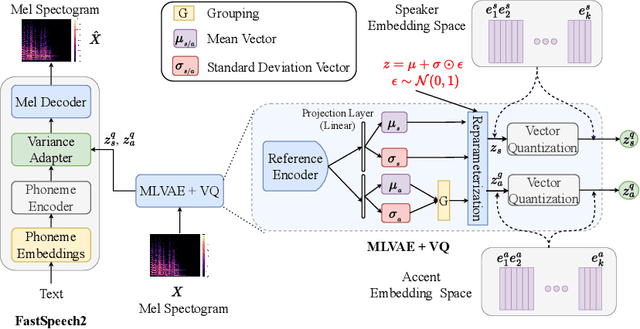
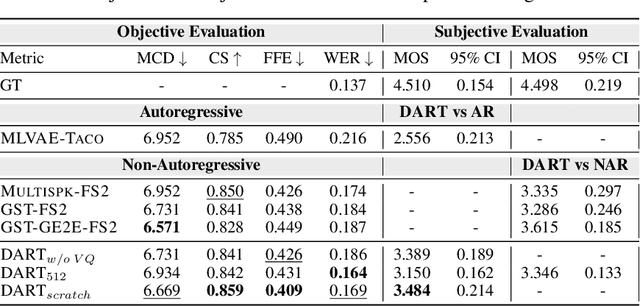
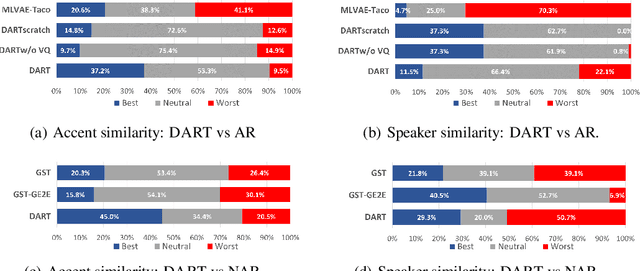

Abstract:Recent advancements in Text-to-Speech (TTS) systems have enabled the generation of natural and expressive speech from textual input. Accented TTS aims to enhance user experience by making the synthesized speech more relatable to minority group listeners, and useful across various applications and context. Speech synthesis can further be made more flexible by allowing users to choose any combination of speaker identity and accent, resulting in a wide range of personalized speech outputs. Current models struggle to disentangle speaker and accent representation, making it difficult to accurately imitate different accents while maintaining the same speaker characteristics. We propose a novel approach to disentangle speaker and accent representations using multi-level variational autoencoders (ML-VAE) and vector quantization (VQ) to improve flexibility and enhance personalization in speech synthesis. Our proposed method addresses the challenge of effectively separating speaker and accent characteristics, enabling more fine-grained control over the synthesized speech. Code and speech samples are publicly available.
Discrete Unit based Masking for Improving Disentanglement in Voice Conversion
Sep 17, 2024



Abstract:Voice conversion (VC) aims to modify the speaker's identity while preserving the linguistic content. Commonly, VC methods use an encoder-decoder architecture, where disentangling the speaker's identity from linguistic information is crucial. However, the disentanglement approaches used in these methods are limited as the speaker features depend on the phonetic content of the utterance, compromising disentanglement. This dependency is amplified with attention-based methods. To address this, we introduce a novel masking mechanism in the input before speaker encoding, masking certain discrete speech units that correspond highly with phoneme classes. Our work aims to reduce the phonetic dependency of speaker features by restricting access to some phonetic information. Furthermore, since our approach is at the input level, it is applicable to any encoder-decoder based VC framework. Our approach improves disentanglement and conversion performance across multiple VC methods, showing significant effectiveness, particularly in attention-based method, with 44% relative improvement in objective intelligibility.
SelectTTS: Synthesizing Anyone's Voice via Discrete Unit-Based Frame Selection
Aug 30, 2024



Abstract:Synthesizing the voices of unseen speakers is a persisting challenge in multi-speaker text-to-speech (TTS). Most multi-speaker TTS models rely on modeling speaker characteristics through speaker conditioning during training. Modeling unseen speaker attributes through this approach has necessitated an increase in model complexity, which makes it challenging to reproduce results and improve upon them. We design a simple alternative to this. We propose SelectTTS, a novel method to select the appropriate frames from the target speaker and decode using frame-level self-supervised learning (SSL) features. We show that this approach can effectively capture speaker characteristics for unseen speakers, and achieves comparable results to other multi-speaker TTS frameworks in both objective and subjective metrics. With SelectTTS, we show that frame selection from the target speaker's speech is a direct way to achieve generalization in unseen speakers with low model complexity. We achieve better speaker similarity performance than SOTA baselines XTTS-v2 and VALL-E with over an 8x reduction in model parameters and a 270x reduction in training data
PRESENT: Zero-Shot Text-to-Prosody Control
Aug 13, 2024Abstract:Current strategies for achieving fine-grained prosody control in speech synthesis entail extracting additional style embeddings or adopting more complex architectures. To enable zero-shot application of pretrained text-to-speech (TTS) models, we present PRESENT (PRosody Editing without Style Embeddings or New Training), which exploits explicit prosody prediction in FastSpeech2-based models by modifying the inference process directly. We apply our text-to-prosody framework to zero-shot language transfer using a JETS model exclusively trained on English LJSpeech data. We obtain character error rates (CER) of 12.8%, 18.7% and 5.9% for German, Hungarian and Spanish respectively, beating the previous state-of-the-art CER by over 2x for all three languages. Furthermore, we allow subphoneme-level control, a first in this field. To evaluate its effectiveness, we show that PRESENT can improve the prosody of questions, and use it to generate Mandarin, a tonal language where vowel pitch varies at subphoneme level. We attain 25.3% hanzi CER and 13.0% pinyin CER with the JETS model. All our code and audio samples are available online.
We Need Variations in Speech Synthesis: Sub-center Modelling for Speaker Embeddings
Jul 05, 2024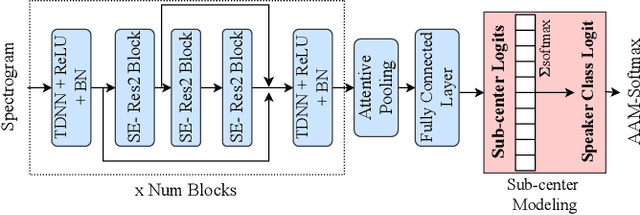
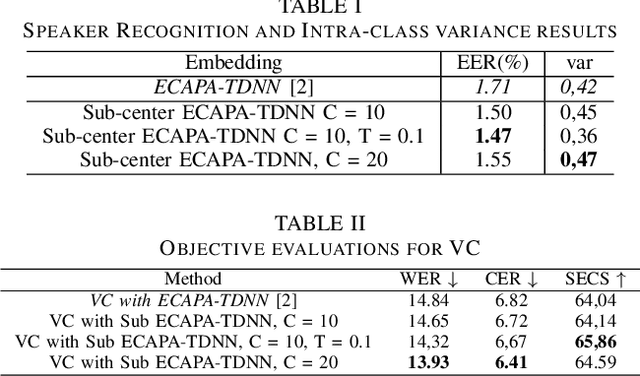
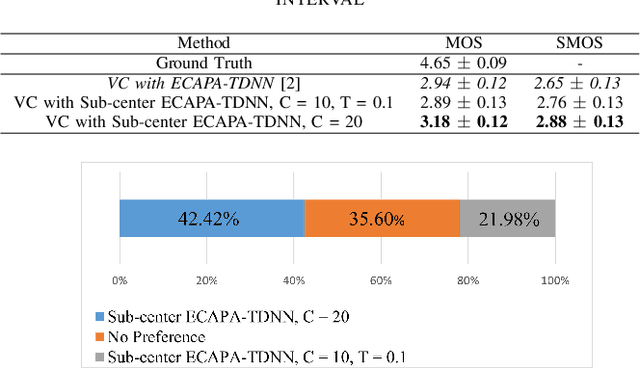
Abstract:In speech synthesis, modeling of rich emotions and prosodic variations present in human voice are crucial to synthesize natural speech. Although speaker embeddings have been widely used in personalized speech synthesis as conditioning inputs, they are designed to lose variation to optimize speaker recognition accuracy. Thus, they are suboptimal for speech synthesis in terms of modeling the rich variations at the output speech distribution. In this work, we propose a novel speaker embedding network which utilizes multiple class centers in the speaker classification training rather than a single class center as traditional embeddings. The proposed approach introduces variations in the speaker embedding while retaining the speaker recognition performance since model does not have to map all of the utterances of a speaker into a single class center. We apply our proposed embedding in voice conversion task and show that our method provides better naturalness and prosody in synthesized speech.
Towards Naturalistic Voice Conversion: NaturalVoices Dataset with an Automatic Processing Pipeline
Jun 06, 2024Abstract:Voice conversion (VC) research traditionally depends on scripted or acted speech, which lacks the natural spontaneity of real-life conversations. While natural speech data is limited for VC, our study focuses on filling in this gap. We introduce a novel data-sourcing pipeline that makes the release of a natural speech dataset for VC, named NaturalVoices. The pipeline extracts rich information in speech such as emotion and signal-to-noise ratio (SNR) from raw podcast data, utilizing recent deep learning methods and providing flexibility and ease of use. NaturalVoices marks a large-scale, spontaneous, expressive, and emotional speech dataset, comprising over 3,800 hours speech sourced from the original podcasts in the MSP-Podcast dataset. Objective and subjective evaluations demonstrate the effectiveness of using our pipeline for providing natural and expressive data for VC, suggesting the potential of NaturalVoices for broader speech generation tasks.
Style Mixture of Experts for Expressive Text-To-Speech Synthesis
Jun 05, 2024Abstract:Recent advances in style transfer text-to-speech (TTS) have improved the expressiveness of synthesized speech. Despite these advancements, encoding stylistic information from diverse and unseen reference speech remains challenging. This paper introduces StyleMoE, an approach that divides the embedding space, modeled by the style encoder, into tractable subsets handled by style experts. The proposed method replaces the style encoder in a TTS system with a Mixture of Experts (MoE) layer. By utilizing a gating network to route reference speeches to different style experts, each expert specializes in aspects of the style space during optimization. Our experiments objectively and subjectively demonstrate the effectiveness of our proposed method in increasing the coverage of the style space for diverse and unseen styles. This approach can enhance the performance of existing state-of-the-art style transfer TTS models, marking the first study of MoE in style transfer TTS to our knowledge.
Accent Conversion in Text-To-Speech Using Multi-Level VAE and Adversarial Training
Jun 03, 2024Abstract:With rapid globalization, the need to build inclusive and representative speech technology cannot be overstated. Accent is an important aspect of speech that needs to be taken into consideration while building inclusive speech synthesizers. Inclusive speech technology aims to erase any biases towards specific groups, such as people of certain accent. We note that state-of-the-art Text-to-Speech (TTS) systems may currently not be suitable for all people, regardless of their background, as they are designed to generate high-quality voices without focusing on accent. In this paper, we propose a TTS model that utilizes a Multi-Level Variational Autoencoder with adversarial learning to address accented speech synthesis and conversion in TTS, with a vision for more inclusive systems in the future. We evaluate the performance through both objective metrics and subjective listening tests. The results show an improvement in accent conversion ability compared to the baseline.
Exploring speech style spaces with language models: Emotional TTS without emotion labels
May 18, 2024

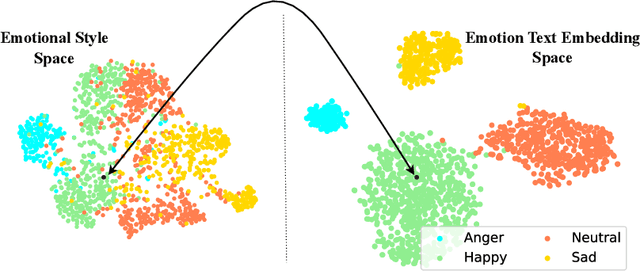

Abstract:Many frameworks for emotional text-to-speech (E-TTS) rely on human-annotated emotion labels that are often inaccurate and difficult to obtain. Learning emotional prosody implicitly presents a tough challenge due to the subjective nature of emotions. In this study, we propose a novel approach that leverages text awareness to acquire emotional styles without the need for explicit emotion labels or text prompts. We present TEMOTTS, a two-stage framework for E-TTS that is trained without emotion labels and is capable of inference without auxiliary inputs. Our proposed method performs knowledge transfer between the linguistic space learned by BERT and the emotional style space constructed by global style tokens. Our experimental results demonstrate the effectiveness of our proposed framework, showcasing improvements in emotional accuracy and naturalness. This is one of the first studies to leverage the emotional correlation between spoken content and expressive delivery for emotional TTS.
Converting Anyone's Voice: End-to-End Expressive Voice Conversion with a Conditional Diffusion Model
May 02, 2024



Abstract:Expressive voice conversion (VC) conducts speaker identity conversion for emotional speakers by jointly converting speaker identity and emotional style. Emotional style modeling for arbitrary speakers in expressive VC has not been extensively explored. Previous approaches have relied on vocoders for speech reconstruction, which makes speech quality heavily dependent on the performance of vocoders. A major challenge of expressive VC lies in emotion prosody modeling. To address these challenges, this paper proposes a fully end-to-end expressive VC framework based on a conditional denoising diffusion probabilistic model (DDPM). We utilize speech units derived from self-supervised speech models as content conditioning, along with deep features extracted from speech emotion recognition and speaker verification systems to model emotional style and speaker identity. Objective and subjective evaluations show the effectiveness of our framework. Codes and samples are publicly available.
 Add to Chrome
Add to Chrome Add to Firefox
Add to Firefox Add to Edge
Add to Edge